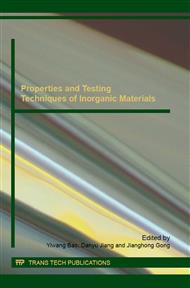[1]
W. J. Choyke, G. Pensl . Physical properties of silicon carbide. MRS Bulletin, 22 (3)(1977): 125-130.
Google Scholar
[2]
J. F. Huang , X. R. Zeng , H. J. Li. Influence of the preparation temperature on the phase, microstructure and anti-oxidation property of a SiC coating for C/C composites. Carbon, 42 (89)(2004): 1517-1521.
DOI: 10.1016/j.carbon.2004.01.066
Google Scholar
[3]
L. F. Cheng, Y. D. Xu, L. T. Zhang . Preparation of an oxidation protection coating for C/C composites by low pressure chemical vapor deposition. Carbon, 38 (5) (2000): 1493-1498.
DOI: 10.1016/s0008-6223(00)00086-5
Google Scholar
[4]
M. W. Chen, H P. Qiu, J Jiao. Preparation of high performance SiCf/SiC composites through PIP process, Key Engineering Materials, 544(2013)43-47.
DOI: 10.4028/www.scientific.net/kem.544.43
Google Scholar
[5]
M. W. Chen, H. P. Qiu, J. Jiao. Thermodynamic Analysis of Chemical Vapor Deposition Progress for SiC Coatings, Key Engineering Materials. 633 (2015) : 83-188.
DOI: 10.4028/www.scientific.net/kem.633.183
Google Scholar
[6]
Y. Lin, L. Chen, Oxidation of SiC powder in SiC/alumina/zirconia compacts, Ceram. Int. 26 (2000) 593-598.
DOI: 10.1016/s0272-8842(99)00102-9
Google Scholar
[7]
P. Mogilevsky, A. Zangvil, Modeling of oxidation behavior of SiC-reinforced ceramic matrix composites, Mater. Sci. Eng. A 262 (1999) 16-24.
DOI: 10.1016/s0921-5093(98)01029-6
Google Scholar
[8]
M. J. F. Guinel, M. G. Norton, Selection criteria for sealing glasses for SiC packaging. J. Non-Cryst. Solids, 347 (2004)173-179.
DOI: 10.1016/j.jnoncrysol.2004.09.002
Google Scholar
[9]
Y. A. Spiridonov, L. A. Orlova, Problems of foam glass production. Glass Ceram., 60 (2003) 313-314.
DOI: 10.1023/b:glac.0000008234.79970.2c
Google Scholar
[10]
E. J. Minay, P. Veronesi, V. Cannillo, C. Leonelli, Control of pore size by metallic fibres in glass matrix composite foams produced by microwave heating. J. Eur. Ceram. Soc., 24(2004)3203-3208.
DOI: 10.1016/j.jeurceramsoc.2003.11.015
Google Scholar


